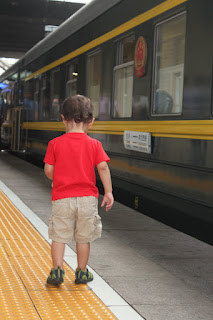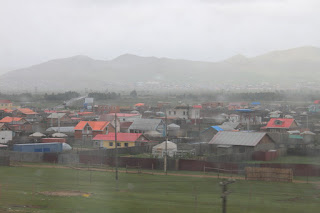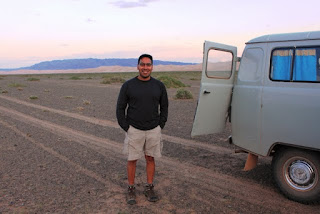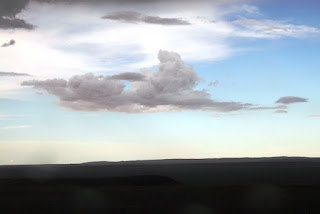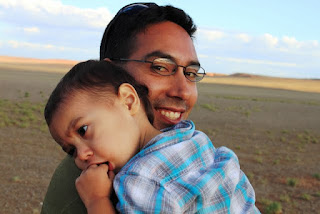During Beijing’s intense summer we found a reprieve to the north in the “Land of Blue Skies”. Our ten day trip in early July began with a 30 hour train ride from Beijing to Ulaanbaatar, Mongolia’s capital and largest city. The Trans-Mongolian railway offered an opportunity to view the contrasting landscape as we traveled northward from eastern China toward the steppes of Mongolia. 
At Beijing Train Station hanging out waiting to embark on the 30 plus hour train ride.
Our lovely accommodations. Not bad though when you get four beds for the price of two and half and our own cabin all to ourselves.
As always, riding the train provided a unique cultural experience. It is as much a part of Chinese culture as is the sport utility vehicle a part of American culture and as such provides an excellent opportunity to observe and visit with Chinese passengers. We met people from all walks of life on the train. Funny enough, on the way back to Beijing we met a family from Houston, Texas. We seem to gravitate toward fellow Texans as this was one of a handful of times in just a few days that we had run into some folks from back home. Coincidence is something. Later on during this trip I ran into a guy in Ulaanbaatar whom I had met over a month earlier in Kathmandu, Nepal. We stopped to eat on the deck outside the State Department Store when I noticed him with some other backpackers. Weirdest thing ever.

Some me time.
Snoozy snoozy. There was a nice breeze blowing through the train providing some relief from the humid summer morning.
Jacob enjoyed the traditional train snacks. Fruit, peanuts, and some special treats that mamma packed.
Like a labrador in the wind. Imagine the experience at a time in your life when "Thomas the Train" is bigger than life itself. Oh and Jacob liked it too!
The top bunk provided hours of enjoyment for jiejie and didi (Chinese for big sister and little brother).
A little more room than the plane to strectch and move around.
Passing by a small town.
We got a little hungry wo we went to the dining car to order some lunch. Its always best to get there early and beat the meal crowds.
This was pretty cool especially if you're a train enthusiast. They pull the train into a large hangar and disconnect all of the cars in order to switch the undercarriages to match the rail gauge at the China-Mongolia border. It takes a couple of hours. Meanwhile no power. It happens around 11pm so good time to go to sleep if you don't mind the violent bumping once they reconnect each car one by one.
Jacob didn't seem to mind.
As we neared Ulaanbaatar there was a rapid change in the weather. We went from hot and steamy to cold and rainy. Luckily this was not a sign of things to come.
Outskirts of Ulaanbaatar.
Our first stop was Ulaanbaatar, the modern capital and economic, political, and industrial center of Mongolia. The total population of Mongolia is over 2 million people with over 1 million people residing in the city. Mongolia has a storied history and is most well known for the vast and ancient Mongol Empire which reached its peak in the late 13th century. This was when Genghis Khan united the tribes of the steppes as one Mongol nation and conquered the most powerful nations of the time in order to create what was arguably the greatest empire of all time. Following the decline of the great Mongol Empire the capital of Mongolia changed several times. Mongolia claimed independence from China in 1911. Mongolia experienced subsequent invasions by China and Russia and finally in 1924 Ulaanbaatar was named the official capital of Mongolia. Mongolia experienced more than seventy years of Russian influence. Former Soviet influence is still visible today in the capital city’s architecture and other aspects of daily life yet Ulaanbaatar continues to experience transition and development.

Shopping at the State Department Store, established in 1921 during Mongolia's communist period, where you can find some great souvenirs and local crafts, and very warm hats. She'll be wishing she bought that come winter in Beijing.
Outside the State Department Store. You can observe the influence of Russian architecture from the Soviet era.
Some of the new architecture. A direct result of the recent mining discoveries that is estimated to provide hundreds of millions of dollars of revenue to Mongolia over the next few decades bringing rapid development and greatly improving the standard of living.
Parliament building in Ulaanbaator's city square.
Recent discoveries of natural reserves of minerals to include copper, gold, coal, and uranium underline the current development and financial potential in Mongolia. Speculators estimate the reserves to be worth nearly $430 billion with enough reserves to mine for the next 50 years. CNN Asia recently did a piece on Mongolia’s development and prospects for the future of the country and its potentially new found wealth. Mongolia’s ancient and nomadic past still impact the country’s economy however the recent discoveries have lead to an increase in foreign investment. Ulaanbaatar is beginning to see the benefits. New development and modern buildings are beginning to spring up around the city.







Today’s Mongolia is vastly different than the ancient Mongol Empire. It possesses neither the power nor the influence of Genghis Khan’s military machine. Mongolia does however still possess the long-term memory linking it to its prestigious past. This is evident in the country’s physical monuments and in its citizens’ pride.
Parliament building with Chinggis Khan in the background.
We expected the vast green pastures as the train neared the capital city however we did not expect the 40 degree temperature and rain. Nevertheless it was a nice break from the humidity of Beijing. After spending a day touring the city center and a night at the Sunjin Grand Hotel we were off to the Gobi Desert aboard an Eznis Airlines small jetliner. Compared to the U.S. and most developed countries it’s relatively difficult to fly. Mongolia only has a handful of airlines. Domestic flights are subject to change daily and it is difficult to book online. Rates are also higher for foreigners. We flew from the capital city into the small town of Dalanzadgad. The flight was about an hour and we paid what it would cost to fly from California to D.C. The adventure in the South Gobi turned out to be worth every penny.
Arriving at the airport and meeting up with our guide and drivers in the middle of the South Gobi Desert.
Outskirts of the small town of Dalanzagdad. People still live in the traditional gers.
Our first stop for lunch.
Our three day tour of the South Gobi Desert far exceeded our expectations. Once we arrived in Dalanzadgad we met our tour guide, driver, and cook. After stopping for supplies we began our overland tour with the two other families we traveled with in some rugged 1960s-70s Russian made vans. The kids loved them. My trip to Tibet was an exercise in travel endurance so I was a bit concerned now that we had the whole family. My concerns were eased a bit since we had two other families and other small children. I knew at least it wouldn’t be a matter of slowing anyone down. This ended up being much different than Tibet. I think every bit as rugged but not as extreme and not as isolated.
Our cook in the background. She was amazing.
Vulture's Valley. We hiked down to a glacier in the middle of the desert.












From Dalanzadgad we traveled to various tourist sites in the Gobi Desert to include Vulture’s Valley, the South Gobi Sand Dunes, and the Flaming Cliffs. We pitched tents at the sand dunes. Near the Flamming Cliffs we had an opportunity to stay with a local nomadic family and observe local customs and culture. This included living in a traditional ger (yert-traditional nomadic tent) and participating in a traditional Mongolian feast. Our guide purchased a goat from some locals earlier in the day. The family we stayed with prepared it. They pressure steamed it by putting the meat along with potatoes and vegetables, and hot stones in an old propane tank and then sealing it and putting it in the open flames. The Mongolian diet was one of the most pleasant surprises. Mongolians are unlike their Asian neighbors. They are meat eaters. Naturally we got along just fine. They are also milk drinkers to include goat’s milk and mare’s milk. We even tried some moonshine made from hand-churned fermented mare’s milk. The milk was less than thirst quenching, especially in the considerably hotter and dryer climate of the South Gobi. The sun was intense during the day but the nights were amazing. The temperature was brisk and the sky was crystal clear. You could see millions of stars after sunset. It was a change from the skies of Beijing. I decided to take full advantage one evening and slept out on the desert floor under the stars. No bugs or snakes but the local dogs woke me up the next morning.

Some great off-roading in between the very tight cliffs.
Almost to the dunes. It ended up being about a six and a half hour road trip from Vulture's Valley. We still had to set up camp and eat. Except for the sand storm we slept very well.
Our camp site.
I woke up early and spotted these camels. They led me to water but I didn't drink.
Climbing the sand dunes 200m above our camp sight. They're know as the Singing Dunes because of the wooshing jetliner overhead noise that they make as you displace the sand and it slides down the dune.
Mongolian horses.
Some goat's milk and homemade bread as we depart the dunes for our next leg toward the Flaming Cliffs.
A local man offered up his home for the night and prepared the fire for the goat feast. Mongolians are proud and friendly. During our stay with a local family in the South Gobi we observed Mongolian hospitality first-hand. This was a last minute arrangement due to a sudden storm. The nomadic family was more than willing to open up their home to visitors. We shared in a traditional feast of goat. They were very hospitable and kind toward the children in our travel group. Like the Chinese they seemed to hold children in high esteem. I would often observe the locals show a sign of affection toward the children by sniffing the top of their head. The customs official on the train as we were heading back to China also did this seemingly customary act.
After about an hour of some intense haggling with a local youth over a handmade camel and goat hair basket we shook hands. It was a great deal for a beautifully handcrafted bag. The kid was tough though.
Prepping the meat.
We did some camel riding before we departed on our final leg in the Gobi Desert.
Saying goodbye to our host family.
I want to stay in the Gobi!
Taming the "Flaming Cliffs".
After the Gobi adventure we returned to Ulaanbaatar to witness the opening day of Naadam Festival. Mongolian society remains deeply connected to its ancient history and culture. There are numerous statues, monuments, and structures symbolic of the ancient Mongol Empire and its most revered leader Chinggis Khan (Ghengis Khan). Naadam, one of the most significant national holidays and celebrations, is held for three days in July. The entire nation enjoys a 7 day holiday. During the first two days of the festival athletes compete in the three traditional “manly” Mongolian sports of horseback riding, archery, and wrestling. The three sports are woven into the cultural fabric of Mongolia. It is not uncommon to see four and five year old boys riding bare back on the short but sturdy horses traditionally used to do battle. We had the opportunity to visit the stadium and festival grounds during the first day of the festival. The atmosphere was a combination a state fair and the Olympics. The nation’s highest officials including the president are in attendance during the opening ceremony and throughout the games. The most coveted competition, wrestling, continues from the first day well into the night and late into the second night when the president crowns the champion. The wrestling competition is a single elimination event with multiple matches taking place centerfield in the stadium. The competition is surrounded by tradition and ceremony. The crowning of the wrestling champion is really considered the end of the actual Naadam games and festival. The third day consists of some smaller events and other activities. The festival is a testament to the pride that Mongolians carry for their country’s history and culture.





I was so proud of that boy. There is a little meateater inside him. He loved the shashlik (kabob). Some of the most tasty kabob I've ever had.
Our final phase of the trip was a drive out east to Gorkhi-Terelj National Park. This natural preserve presented an entirely different aspect of Mongolia’s geography and climate. The green landscape and blue skies with surrounding mountains were in stark contrast to the Gobi desert and more reminiscent of the United States’ mountain-west region. We spent a night in a ger and enjoyed watching the final wrestling matches in the lodge. There was great hiking, horseback riding and other outdoor activities.
Terelj National Park.
Mongolian wrestling on the tube in the lodge.
While Karen went horseback riding we went hiking.
Mongolia remains one of our best trip experiences of 2011. From the city, to the desert, to the mountains Mongolia offers a culturally rich adventure for anyone who loves the outdoors and an escape from the summer heat of Beijing.
Crossing the China-Mongolia border.
 The one constant in China for us has been the excruciatingly slow internet. This has made blogging an unexpected challenge so I'm trying a new method this trip. We'll try for shorter posts along the way rather than trying to publish a novel at the end of the trip. We began on February 24th with a 24 hour train ride from Beijing to Guilin. Guilin is a pleasant departure from the pollution of Beijing. It's best known for the towering karst formations, scenic Li River, and all around natural beauty. We took a boat ride down the Li River 83 kilometers to the town of Yangshuo and visited the nearby village of YuLong. This tiny village has a small tributary running through the rice fields. The village, mostly inhabited by elders and a handful of children, still has structures built during the Qing Dynasty in the late 1800s. The parents of the children were no where to be seen and were most likely away in major cities working. We watched the fisherman with their Camarand birds and small bamboo boats go to work. These are apparently some of the last Camarand fisherman in China.
The one constant in China for us has been the excruciatingly slow internet. This has made blogging an unexpected challenge so I'm trying a new method this trip. We'll try for shorter posts along the way rather than trying to publish a novel at the end of the trip. We began on February 24th with a 24 hour train ride from Beijing to Guilin. Guilin is a pleasant departure from the pollution of Beijing. It's best known for the towering karst formations, scenic Li River, and all around natural beauty. We took a boat ride down the Li River 83 kilometers to the town of Yangshuo and visited the nearby village of YuLong. This tiny village has a small tributary running through the rice fields. The village, mostly inhabited by elders and a handful of children, still has structures built during the Qing Dynasty in the late 1800s. The parents of the children were no where to be seen and were most likely away in major cities working. We watched the fisherman with their Camarand birds and small bamboo boats go to work. These are apparently some of the last Camarand fisherman in China.









